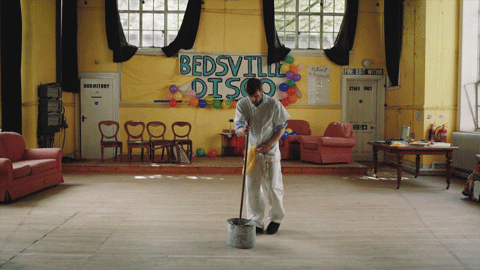Dialogue is both a pleasure and a pain. Throwing lines on a page is an easy way to increase your word count but writing well-written dialogue can be one of the most difficult parts of the screenwriting process.
Today we are going to share with YOU what WE learned from making a film that included only one word of dialogue. Check out The Asylum Groove below if you want to see the finished film.
Nate over at Nate’s Film Tutorials challenged us to make a film with one key restriction: “you can only use one word of dialogue”.
This was a great challenge for us because we’ve been learning about different screenwriting techniques on the channel and wanted to put them all into practice.
So we knew a few things which would help us along the way:
- Firstly, the story needed to be 100% visual; no bloated backstory, a nice simple structure, a single goal, a single obstacle, and all represented on-screen through action.
- Secondly, limiting a character’s lines on screen is easier if they don’t have someone with which to communicate. So we decided to make it about one character in a single location.
This also helped keep the costs down and would speed up the production process, so happy days!
We knew we had access to an old school assembly hall through a contact with our previous film. From the moment we saw the location, we knew we wanted to make a film which looked and felt like the film One Flew Over a Cuckoo’s Nest.
At first we found writing the initial idea quite difficult. What should the word be? When should it be said? We soon realised that the word was becoming the focus of the script. Instead we decided to write the film without ANY dialogue and add a word back in where it would pack a punch.
So now we had a location, a character, and an initial direction to base the script on. We just had to give him a goal to achieve, some conflict to overcome, and some interesting characteristics.
A film without dialogue needs to get the character off their feet, moving around, and completing a task. This creates movement in the scene, gives the actor something to do, and gives the audience something to look at.
We gave the character a mop and a bucket and tasked him with cleaning the assembly hall for the Bedville Disco. Because we can’t explain the backstory of the character through interaction with another character or any form of dialogue, we had to make sure that it was his costume and the set which gave the audience clues about him and his surroundings.
His goal to mop the floor is soon taken over by his desire to dance to the music, which can be considered an obstacle.
Dancing then transforms into his goal, which means another obstacle must be written in. He soon trips over the bucket and spills the water.
His next goal is to clean up the water. What’s stopping him at this point is his moment of ecstasy as he splashes in the water.
His final obstacle is when he is trapped in the electric chair. He wants answers, he wants to be set free. His final tactic is to cry for help and thrash around in the chair.
We now have a character with a set of obstacles to overcome in order to achieve his goals, but there is something missing. We need to give him character.
Because this film is so short and essentially quite simple (one character, one location, and mundane tasks) the focus of the film was to create a lovable character through his actions and reactions, then flip our perception of the character on its head right at the end.
Because it's such a short film, we wanted to make sure it had a strong bite which left you remembering the story.
So how do you build up a likeable character without dialogue? Empathy.
The story is told through the character’s actions, and we learn the type of character he is through the way in which he performs them.
To create an empathetic character; someone we can relate to, enjoy their on-screen presence, and understand their troubles, we needed to familiarise his actions in this unique scenario.
Not everyone has been locked inside an insane asylum, but i’m sure we’ve all danced like nobody's watching. And if you are new to screenwriting, we have a video about the basics:
So, even though our character is in a place which most of us have little experience with, he’s human after all, and its those human moments which we connect to. We’ve all experienced: boredom, confusion, nostalgia, delight, panic, and rage.
Adding the word “Mama” into the story was the final moment of impact.
Because we only had a single word to use, it became very powerful. Everything was held up by this word, and the choice of word was important.
We toyed with having the character accepting death in the electric chair, saying the word “Ready”. We thought that way he was technically achieving his goal of accepting death.
Then we changed it to “No!” which flipped the film on its head and gave us the impact which we wanted.
Then we decided on using the word “Mama”. This helped couple the childlike mannerisms of the character, almost everyone understands a relationship between mother and son, and because that word is universally understood and means so much in so little, it gave us the hard hitting impact which we wanted.
Alfred Hitchcock is quoted as saying “Dialogue should simply be a sound among other sounds, just something that comes out of the mouths of people whose eyes tell the story in visual terms.”
Try grabbing your latest script, remove the dialogue, and see how much of the story is retained. This will test your script to see if you are writing something visual and you’ll be able to work out if you are relying too much on dialogue to further the plot.
Making a film without any dialogue, or in our case, a single repeated word, definitely gives you a better perspective on how precious dialogue can be and why we don’t always need to use words to tell a visual story.
This is just our process, so let us know what tips YOU have for writing a film with very limited dialogue.
This video was Sponsored By
🚀 http://bit.ly/tflrs-creator - Become a social media powerhouse with RocketStock's video element pack, Creator. This collection comes packed with logo reveals, end screens, subscribe animations, and much more.
🎵 http://bit.ly/pbtfl-howweroll - Click here to download this episode's track. Check out Premiumbeat.com to discover a huge range of exclusive royalty free music!
DISCLAIMERS:
Some of these links are affiliate links, if you purchase gear via these links The Film Look will receive a small commission, but there will be no additional cost to you. Thank you!





